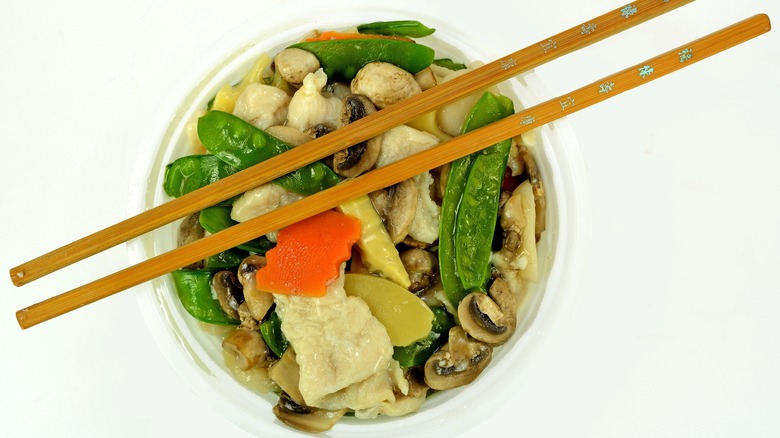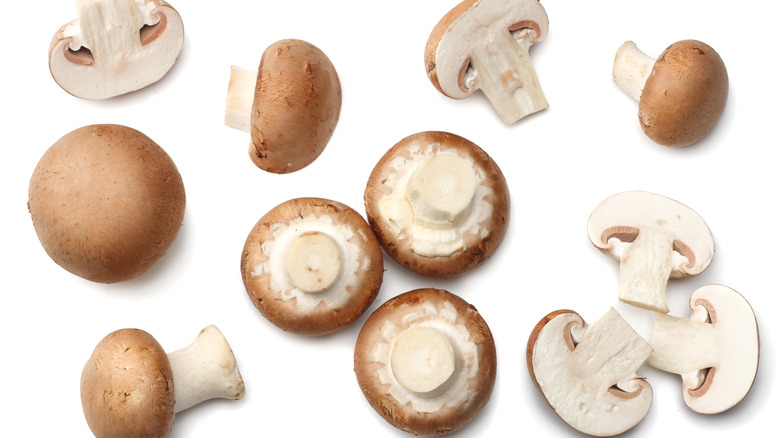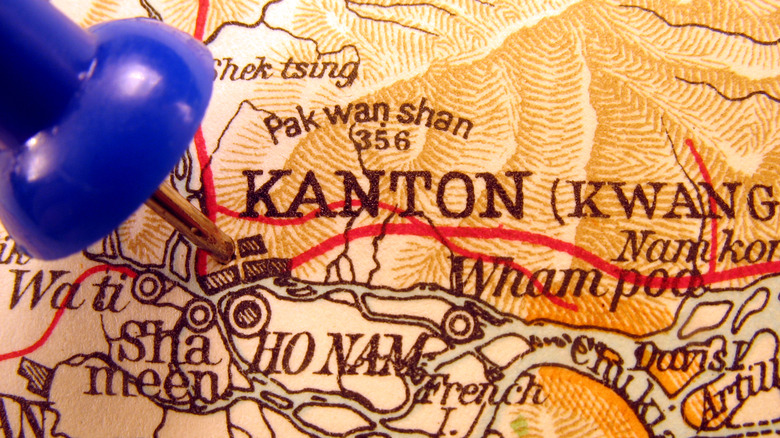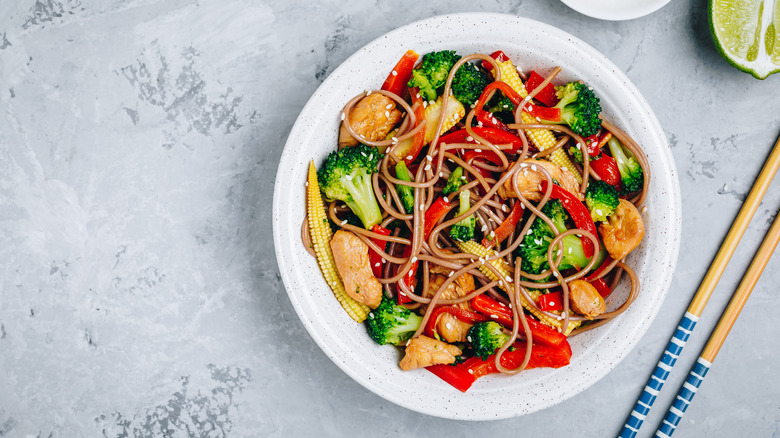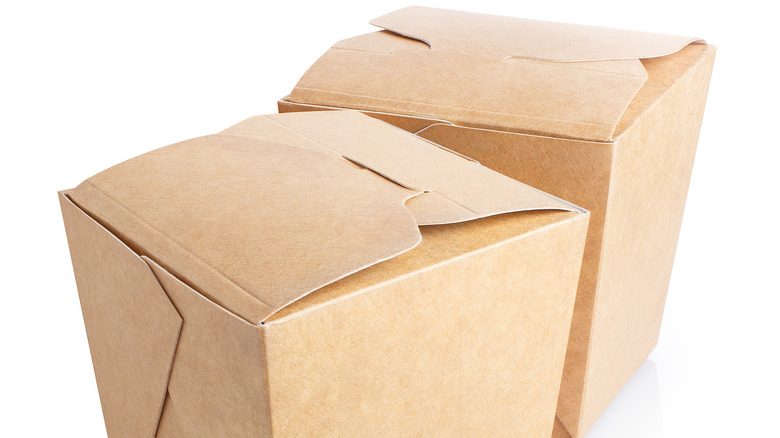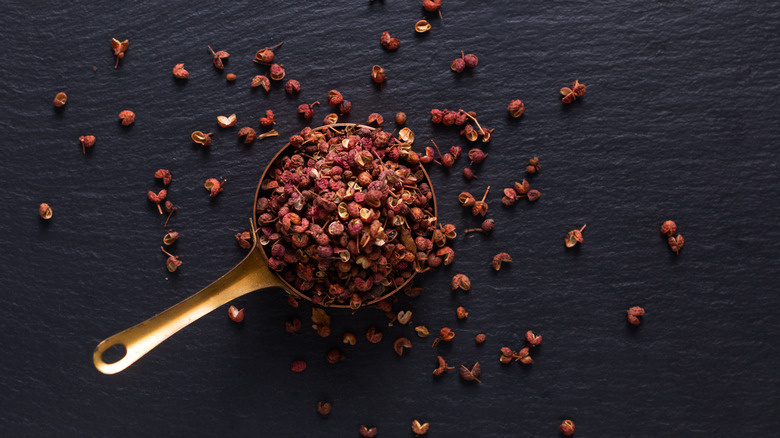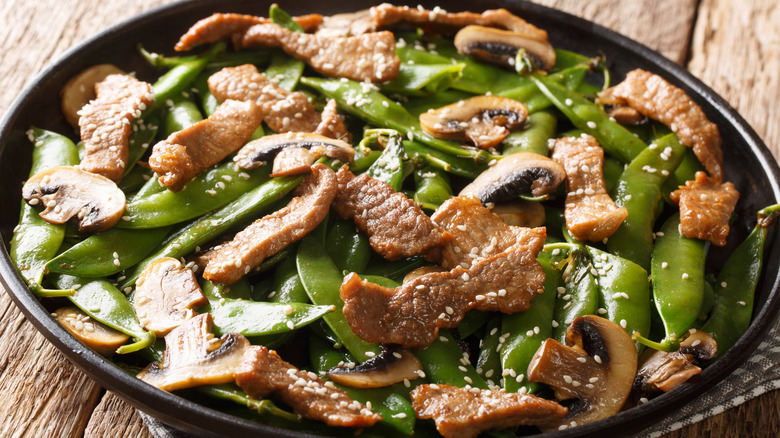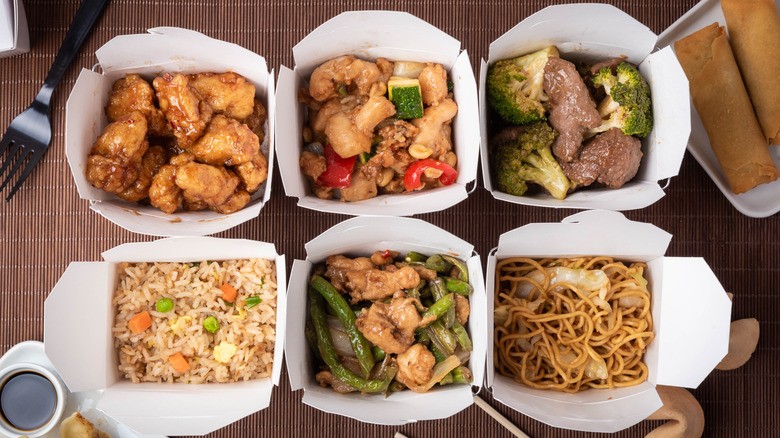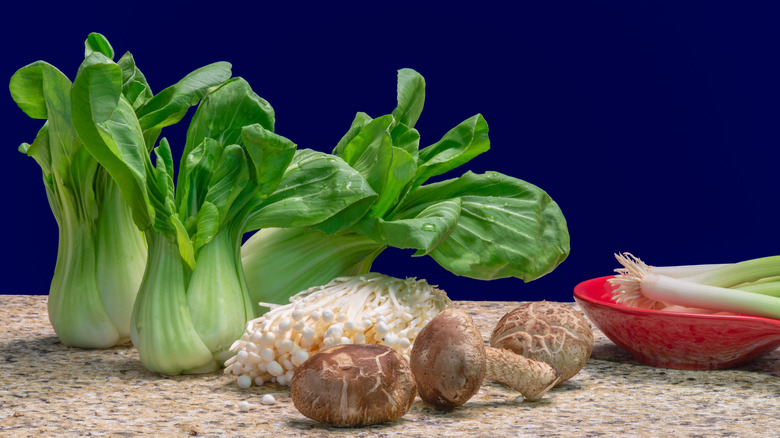The Untold Truth Of Moo Goo Gai Pan
Moo goo gai pan is a fixture of American-Chinese food; mention the name of the chicken and mushroom dish, and it's likely that people will recognize it as a classic Cantonese recipe. Even though it didn't show up in Grubhub's survey of the most popular Chinese dishes in 2015, it's by no means obscure. However, it is a dish that, to those unfamiliar with the evolution of Chinese food in the U.S., may seem like one of those invented recipes that were passed off as Chinese food to unsuspecting diners.
That's not the case with moo goo gai pan. This dish has a history that goes back to traditional Chinese cuisine, and it has long been one of the more common recipes on Chinese restaurant menus in America, starting from the 1800s when immigrant cooks were just trying to feed other Chinese workers. While moo goo gai pan continues to feed families looking for a fast, healthy meal in the 21st century, let's take a look back at the dish's untold truth.
It's an Americanized version of an authentic Chinese dish
A stir-fried dish of chicken slices and mushrooms really does exist in traditional Chinese cuisine. The Americanized moo goo gai pan recipe has more vegetables and a thicker sauce, but it's not a dish that was totally invented in the U.S. (via Omnivore's Cookbook). According to the American Chinese Food Show, the name "moo goo gai pan" is based on the name "moh gu gai pin," which is a literal translation of "mushroom" and "chicken pieces." Moo goo gai pan also contains vegetables like bok choy and water chestnuts.
One major difference you'll find between the traditional and American-Chinese recipes is that the sauce in the traditional version is a thin white sauce, made with chicken broth, scallions, ginger, and garlic, but without any soy sauce (via The Woks of Life). However, many American versions contain a little bit of soy sauce along with many other vegetables. You'll also find oyster sauce in some renditions. The choice of mushroom is up to you, although recipes tend to use button or similar varieties.
The name moo goo gai pan is likely rooted in Taishanese
Most of the early Chinese immigrants to the U.S. were not Mandarin speakers from China or Taiwan; they came from the southwestern corner of the province of Guangdong, or Canton, as it was romanized back then (via RADII). That southwestern section of the province was called Taishan or Toisan, and it has its own language, Taishanese, that is related to Cantonese but with notable differences in tones and pronunciation. While the American-Chinese cuisine that sprang up in the 1800s was called Cantonese food, it actually was based on cooking by Taishanese immigrants, and the English pronunciation of "moo goo gai pan" was likely based on Taishanese instead.
The American Chinese Food Show looked at old American-Chinese menus to show how many familiar "Cantonese" recipe names are derived from Taishanese pronunciation. Some are obvious, as the entire name uses Taishanese words that aren't used in Cantonese. Others, however, look like they could be either Cantonese or Taishanese save for one telltale vowel. This is the case with moo goo gai pan, as the Taishanese word for slices or pieces is pronounced more like "pan," while the Cantonese word is pronounced more like "pin." Other familiar names that may be based on Taishanese pronunciation include chow mein.
Moo goo gai pan is not the same as chicken-vegetable stir fry
The Americanized version of moo goo gai pan allows you to add whatever vegetables you want, leading to some confusion about whether the dish is really just stir-fried chicken and vegetables. While it is technically stir-fried chicken and vegetables, it's not the same as the general chicken-veggie stir-fries listed on menus. Moo goo gai pan must have mushrooms, even if there are other vegetables included; take away the mushrooms, and you end up with a different dish. The same goes for the chicken (via Red Cook).
Despite the very specific mention of chicken and mushrooms in the name, you might still find restaurants that completely mess this up and give you something with the wrong meat and no mushrooms. Kian Lam Kho of Red Cook mentions how he was looking forward to eating some moo goo gai pan only to find that the chef of that restaurant made it with pork instead of chicken, plus a bunch of other vegetables that did not include mushrooms.
You can thank impoverished artists for the popularization of American Chinese food
Initially, Chinese food in America was made for and eaten by other Chinese. Non-Chinese diners, especially white diners, were not interested at all in trying Chinese food. In fact, they avoided it, deeming it strange and unappetizing. Racism toward Chinese immigrants fed the belief that Chinese food consisted of rats and other animals considered unfit for consumption (via Oxford Research Encyclopedia of American History). However, toward the later part of the 1800s, white diners –- namely "broke New York artists" (via 10Best) –- looking for both a cheap meal and an adventure decided to try Chinese restaurants. This attention shined a spotlight on American-Chinese food, drawing in more and more non-Chinese customers and influencing Chinese cooks to adjust recipes to suit these customers' tastes (via UCLA).
By the 1920s, "chop suey houses" flourished, with many restaurants turning into fancier versions of themselves due to restrictions placed on Chinese immigration by the Chinese Exclusion Act (via Culture Trip). This law, which barred most immigration to the U.S. from China, made an exception for high-end restaurant workers. One of the more popular dishes at this time was moo goo gai pan (via Association for Asian Studies).
Chinese recipes became Americanized partly because Chinese ingredients were hard to find (or illegal)
While immigrant Chinese cooks made some changes to recipes to make them more accessible to non-Chinese customers' liking, many of the changes were made simply because the cooks had no other choice. Ingredients used in China often weren't available in the United States in the 1800s; for example, the American-Chinese dish of beef and broccoli is descended from a traditional Chinese dish of beef and broccoli –- but the Chinese version used gai-lan, a related but different vegetable that was not available to those first immigrant Chinese cooks in the U.S. Western broccoli was the closest substitute available (via Insider).
In at least one case, a key ingredient in the traditional Chinese recipe was actually illegal and thus impossible to get in the United States. Sichuan pepper is essential when making gong bao ji ding, the traditional Chinese version of kung pao chicken. However, Sichuan peppercorns were banned from import into the U.S. from 1968 to 2005 because of the risk that it could carry a fungus that was known to decimate citrus crops, which would have been disastrous for citrus orchards in the country (via South China Morning Post).
A cookbook from the 1950s had a recipe for moo goo beef
It's not unusual to find recipes where the cook changed a main ingredient and then stuck that new ingredient in the classic recipe name, such as putting Tex-Mex-style filling in an egg roll wrapper and calling it a Southwest egg roll. This has happened to moo goo gai pan, too. One cookbook from the 1950s actually had a recipe for "moo goo ngow," or moo goo beef (via Old Thyme Recipes). "Ngow" is a romanized version of the Cantonese word for beef. The recipe calls for mushrooms and steak along with some of the ingredients you might find in the chicken version, such as garlic and corn starch. However, it also calls for soy sauce, which is not a typical moo goo gai pan ingredient.
There really is a Chinese dish of stir-fried beef and mushrooms, by the way (via The Woks of Life). However, it uses a brown sauce instead of moo goo gai pan's typical white sauce, and usually, you just see it called something like "beef and mushroom stir fry." Where the cookbook author got the specific name of "moo goo ngow" from is unknown.
The treatment of American-Chinese food as legitimate is seeing a wave of support
A dish usually labeled as American Chinese is either food you won't find in China or a recipe that has been modified enough as to not look or taste exactly the same as what you might get in a restaurant in Guangzhou or Hong Kong (via Spoon University). This plus the tendency to serve food that was very sweet and overly sauced gave American-Chinese food an unfavorable reputation among foodies, with many people dismissing it as not authentic and not worth eating.
But more people have spoken up in favor of American-Chinese food being a legitimate overseas-Chinese cuisine. Dishes like moo goo gai pan did originate in China, and changes to the recipes were made out of necessity because the cooks didn't have access to many familiar ingredients. In a commentary for CNN, journalist Clarissa Wei writes that just as the different regional cuisines of China have their signature tastes –- Sichuanese food is spicy, Shanghai food is sugary, and so on –- American-Chinese cuisine has its own signature taste that just happens to be "meaty, deep-fried, and saucy." In fact, you could argue that there's no such thing as "Chinese food" considering the wide range of cuisines in different regions throughout the country.
Moo goo gai pan is one of the healthiest recipes in Chinese cuisine
When Chinese immigrants opened restaurants stateside back in the 19th century, the changes they made to their recipes included making the food sweeter and fattier (via RADII). Even today, many American-Chinese restaurants make food that is saucier, saltier, fattier, more sugary, and more deep-fried than what you'd find in the original recipes (via Healthline). Research shows that almost all restaurant food in the U.S., regardless of cuisine, trends toward the unhealthy end of the spectrum, so this isn't a problem limited to only American-Chinese food (via Healthline).
The reliance on salt, oil, and sugar in these American-Chinese recipes means that it can be more difficult to order a meal that fits dietary restrictions. If you're looking for a healthier option at a Chinese restaurant in the U.S., moo goo gai pan is a good choice (via Insider). It really is a very nutritious recipe with a large amount of vegetables plus lean protein from chicken.
